Remembering Arthur Berger (original) (raw)
Grant Chu Covell
[April 2005.]
Composer, critic and teacher, Arthur Berger passed away on October 7, 2003 at 92. Berger was born in 1912, the same year as John Cage. He studied music in New York City, attended Harvard, and then went to Paris to study with Nadia Boulanger. Back in the US, he taught at Mills College where he befriended Darius Milhaud. In the Forties, Berger moved back East to be music critic for the New York Sun. Later, at Virgil Thomson’s invitation, he joined the New York Herald Tribune. An early defender of neoclassicism, Berger described and named Stravinsky’s octatonic scale. His 1953 book on Copland was the first serious consideration of any American composer. That same year he settled down to teach at Brandeis University where he was instrumental in establishing national standards for the Ph.D. in music composition. He was a founding editor of Perspectives of New Music.
I met him long after he retired, his age entitling him to a certain degree of crotchetiness. I recall him scurrying home from a party to catch a Puccini opera telecast. We joked that at his age he certainly ought to know what happens to Mimi.
I got to know him better while he was working on his last book, Reflections of an American Composer (University of California Press, 2002), in which he clearly explains the basis for several 20th-century American composers’ preoccupations: the friction between the neoclassical (Stravinsky) and serialist (Schoenberg) camps, and how America’s academic institutions evolved. Rich with anecdotes, Reflections is essential reading for anyone who has ever wondered why today’s music criticism behaves more like entertainment or why American composers are such a fractious bunch.
Arthur would call me for computer help. I’d resurrect lost chapters and then we’d talk about music. As a composer in suspension in the Great Vacuum, I welcomed the opportunity to show him my stuff. We’d withdraw to his piano, and with great concentration he would slowly consider my score. I’d stare at the original artwork and photos that covered his ground-floor studio’s walls: Paintings and collages by his wife Ellen Berger and Robert Rauschenberg intermingled with yellowing autographed images of Copland, Milhaud and Stravinsky among other colleagues and students. Bookshelves were crammed with books, scores, LPs, tapes and CDs, with musical periodicals stacked everywhere.
Arthur always delivered blunt verdicts: “This is good,” or more frequently, “I don’t understand what you’re doing here.” While he recognized that I was using a system — we never discussed choosing pitches — he always preferred to discuss how music progressed through time, how a gesture might sound, or how one phrase balanced another. He would play a few notes. Actually, Arthur would interpret a page’s notes, and then explain how this phrase merited an accent or how that duration should be lengthened to make a more satisfying line.
Arthur’s advice was always practical. He’d reach for his own scores to illustrate points. In one piece’s opening measure, the flute enters a sixteenth-note after the other players. “This never worked. The flute always sounds late, unintentional. I don’t know how to get that effect to work.” His candor surprised and delighted me. I returned to the drawing board feeling a lot less incompetent.
As a lark, I submitted an orchestral work to an open-reading competition. I needed a qualifying letter and so asked him. “Of course you’ll never win anything with this. It’s unfashionably hard and dissonant. No one is interested in music like this any more.” I knew my chances were slim, but his assessment pleased me.
We tried to talk about contemporary music. I was eager for his impressions and valued his perspective. But in retirement his exposure was limited to concerts featuring colleagues and students amid Boston’s relatively conservative new-music fare. Cage was forever the rascal who wrote some percussion pieces, prepared the piano, and wrote four-and-a-half minutes of silence. He was unfamiliar with the Music For series and the late number pieces. Similarly, Feldman composed graphic scores and went on to write long, slow works. Boulez and Stockhausen were dismissed for writing “that kind of music.”
I attempted to explain my enthusiasm for Aperghis, Ferrari, Lachenmann, Scelsi and Xenakis, but they were all Europeans who had taken a different road. He’d nod knowingly while I fumbled for words, and I never knew whether it was his music critic’s practiced politeness or that his deafness couldn’t keep up with my all-too-rapid patter. He once pulled out a score by Francesconi — I was surprised he had it — and pointedly asked: “Is he one of your people?”
Arthur’s best advice was fundamental. He insisted I write only meaningful music. I shouldn’t waste time hacking at old pieces or cobbling pastiches, which I used to do during the rare free moment. I should labor on something substantial, even if performance hopes were nil. He thought I should continue working in the electroacoustic realm because realizations were immediate. [**This has long been an attraction among composers who employ electroacoustic means. Ed.**] Was he politely suggesting I should stay away from conventionally notated music and instruments? With no time to act on good advice, I’ve become comfortable writing nothing at all.
* * *
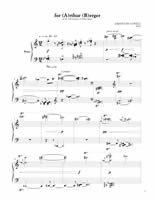
Click on the image to open a .pdf file.
* * *
Berger’s sparse but finely wrought output spans more than seven decades. Hardly a dilettante, he absorbed both neoclassicism and serialism, forging a distinct style which Babbitt aptly characterized as “diatonic Webern.” We’ve recently seen complete sets of piano music and orchestral works joining several reissued chamber-music recordings. The vocal and choral works are underrepresented.
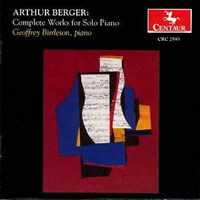
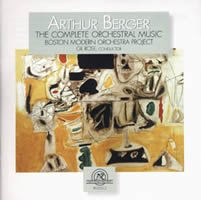
Complete Works for Solo Piano. Arthur BERGER: Episodes (1933); Fantasy (1942); Rondo (1945); Three Bagatelles (1946); Partita (1947); Four Two-Part Inventions (1948-49); Three One-Part Inventions (1954); Five Pieces for Piano (1969); Birthday Cards (1980-1994). Geoffrey Burleson, piano. Centaur CRC 2593 (http://www.centaurrecords.com/).
The Complete Orchestral Music. Arthur BERGER: Ideas of Order (1952); Perspectives II (1985); Serenade Concertante (1944, rev. 1951); Prelude, Aria and Waltz (1982); Polyphony (1956). Boston Modern Orchestra Project, Gil Rose (cond.). New World Records 80605-2 (http://www.newworldrecords.org/).
I had the good fortune to hear some of Geoffrey Burleson’s recordings before Centaur released them. As the pianist had taken the initiative to organize them into a suite, Berger was eager to know how the Birthday Cards collection held together. The eight miniatures straddling 15 years exemplify Berger’s economical and colorful style. Listen closely and you can hear the prominent E’s and C’s in the birthday piece for Elliott Carter. I’m sure there are similar touches in the birthday greetings for Aaron Copland and Gunther Schuller.
Berger wrote lucid and tuneful piano music throughout his career. The confident early works include 1933’s three jazzily smooth Episodes, the 1942 Fantasy with its gentle, show-tune appeal, clothed in halting neoclassical rhythms, and the 1945 Rondo. From the mid-1940s to the end of the Fifties, formality overshadows Berger’s fluidity: The Partita and two collections of Inventions are cooler and less distinctive. The 1969 Five Pieces are ingenious. From the piano’s 88 keys, Berger extracts maximum variety and color, including the odd prepared and interior sound. With their gently parodied skittish serialist gestures and false endings, I hear humor in the set.
Ideas of Order may be Berger’s masterpiece, a variation set commissioned by Dimitri Mitropoulos for the New York Philharmonic, taking its name from Wallace Stevens’ poem collection. At first blush, Berger’s orchestral works resemble serial Stravinsky. The canvasses from the 1950s, Ideas of Order and the harder-edged Polyphony could be missing pages from the Russian émigré’s Agon, except that Berger’s earnestness trumps Stravinsky’s aloofness. While I enjoy Mouvements, I’ve always thought its composer was donning serialism’s mantle insincerely. Berger’s modernist palette reveals darting glances at Webern between the prairie-like Coplandisms. It’s rather astonishing how the music teeters between domains. The concise Prelude, Aria and Waltz is an unusually aggressive collection for string orchestra, the antipode of Warlock and Holst’s folksong garlands. BMOP delivers a deservedly innocent freshness to these pieces.
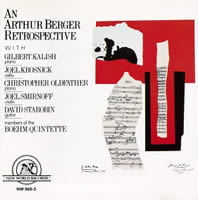
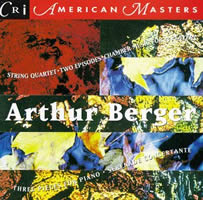
An Arthur Berger Retrospective. Arthur BERGER: Duo No. 1 for Violin and Piano (1948); Quartet for Winds (1941); Duo for Cello and Piano (1951); Duo for Oboe and Clarinet (1952); Trio for Guitar, Violin and Piano (1972). Sheryl Henze (flute); Phyllis Lanini (oboe); Don Stewart (clarinet); Robert Wagner (bassoon); Joel Smirnoff (violin); Joel Krosnick (cello); David Starobin (guitar); Christopher Oldfather, Gilbert Kalish (pianos). New World Records 80360-2 (http://www.newworldrecords.org/).
Arthur BERGER: Three Pieces for Two Pianos (1961); Serenade Concertante (1944, rev. 1951); String Quartet (1958); Two Episodes (1933); Chamber Music for 13 Players (1956). Paul Jacobs, Gilbert Kalish, Robert Helps (pianos); Brandeis Festival Orchestra, Izler Solomon (cond.); Lenox String Quartet; Columbia Chamber Ensemble, Gunther Schuller (cond.). CRI 622 (http://www.newworldrecords.org/).
Berger’s chamber music contains some of the 20th century’s clearest textures. Duo No. 1 for Violin and Piano succeeds at its neoclassically patriotic, Copland gambit. The jovial wind quartet is innately American, though with a French twist. The Duo for Cello and Piano’s expressively cavorting lines gave rise to Babbitt’s “diatonic Webern” characterization. The mercurial and transparent Trio for Guitar, Violin and Piano is one of my favorites. Berger cleverly uses a few prepared-piano pitches that bind the guitar and string timbres. New World Records captures great players in dedicated performances.
On the CRI disc, Jacobs and Kalish are brilliant at the Three Pieces for Two Pianos, originally released in 1972. Serenade Concertante and the skittish String Quartet are reissued mono recordings. Berger’s interpreters seem to come down on the neoclassical or serial side, with this disc emphasizing the Schoenbergian aspect.
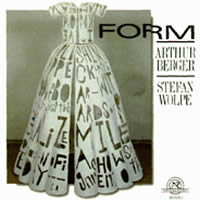
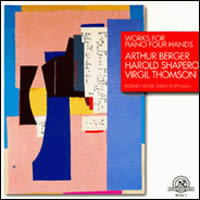
I never heard Arthur speak ill of a colleague or peer. He admired Stefan Wolpe and Harold Shapero, two composers with whom he shares CDs. On New World Records 80308-2, the Contemporary Chamber Players directed by Arthur Weisberg present Wolpe’s Form for piano and Piece in Two Parts for Solo Violin alongside Berger’s spiky Septet (1965-66) and Robert Miller’s zinging Five Pieces for Piano. Piano four-hand duo David Kopp and Rodney Lister present works by Virgil Thomson and Shapero alongside Berger’s Composition for Piano Four-Hands (1978), Suite for Piano Four-Hands (1945/47, 1980) and Perspectives III (1982) on New World Records 80536-2.